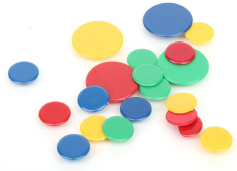This problem solving activity has an algebra focus.

Place twenty-one counters in a row.
With a partner take turns, removing one, two or three counters each turn.
The person to remove the last counter is the winner.
Is "Take three or fewer" a fair game? (In a fair game, each player has an equal chance of winning.)
- Identify patterns used in solving the problem (multiples of 3).
- Devise and use problem solving strategies (draw a picture, use equipment, work backwards).
This is an open problem, presented as a game, that involves decisions and fairness. Students learn that if the game is fair, then it doesn’t matter who starts, as each player is equally likely to win. If the game is not fair, then a decision must be made about who will win, the first player or the second player. By playing a number of games, students have the opportunity to begin to see a pattern, and to identify a strategy. This game could also be played as follows: students play the game without counters, keeping track of their moves mentally as they subtract one, two or three. Whoever can go to zero, wins.
A very similar problem is Take Two, Algebra, Level 3. As this is easier, you may want some of your class to try it first.
The Problem
Play the strategy game "Take three or fewer".
Place twenty-one counters in a row. With a partner take turns, removing one, two or three counters each turn. The person to remove the last counter is the winner.
Is "Take three or fewer" a fair game? (In a fair game, each player has an equal chance of winning.)
Teaching Sequence
- Introduce the problem by playing one game with the class.
- Read the problem.
- Ask the students to clarify when a game is fair or unfair. (If there is an advantage in being the first or second player then the game is not fair.)
- Let the students play the games in pairs. It is important to stress the idea that they are playing the game together to see if they can work out a winning strategy for the first player. By doing this you are encouraging them to analyse the game rather than just trying to beat their opponent.
- As the students play the game ask questions that focus their thinking on the patterns that they are using to find a winning strategy:
What have you noticed in playing this game?
If you are the first player how many counters should you take? Why?
Do you prefer to be the first or second player? Why?
Did you feel the game was fair? Why/why not?
Have you noticed any patterns in the game? - If the students are having problems looking for patterns suggest that they start with a smaller number of counters (7).
- When the students think that they have a strategy for "winning" the game, let them try their strategy out with another pair. (At this stage ask the students to keep their ideas to themselves.)
- Once the pairs have played a couple of games ask them to share and discuss their ideas with the other pair. Have the group of 4 write down their method for "winning" the game and their ideas about whether the game is fair or not.
- Share strategies for playing the game.
- Discuss: Do you think that the game is fair? Why or Why not?
Extension
Change the number of counters to 57 or any other number you prefer.
Change the number of counters that can be taken to one two, three or four.
Solution
A good problem solving strategy is to try a simpler problem. If your students haven’t done the problem Take Two, Algebra, Level 3, and they are having trouble with this present problem, then we suggest they try this easier problem first.
The strategy here is very similar to that in Take Two. In Take Three, if only one, two or three counters are left, then they can be removed for a win. On the other hand, four counters is a losing position. The next losing position is eight as a pile of eight can be reduced to four by the second player no matter what the first player does.
The losing numbers of counters are then twelve, sixteen, and twenty. So the first player, when faced with twenty-one, takes one counter away. Then the second player is on a losing number and should lose if the first player plays correctly. By ‘correctly’ here, we mean that, after the first move, if the second player takes x counters, the first player should take 4 – x, so that after these two moves, the pile is reduced by four to the next losing position.
This is therefore not a fair game as it is biased to the first player. On the other hand, any number of counters other than a multiple of four gives a win to the first player. If there are a multiple of four counters in play at the start, then the second player wins.
Solution to the Extension
Here the losing numbers are multiples of five. So the first player wins if there are not a multiple of five counters originally; the second player wins if there are.